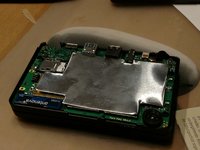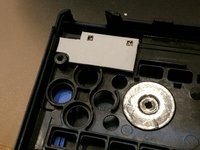Just some quick newspost, as it's late and I'm dead tired already...
But I hope you'll like it
Cooling, part 1
I'm still waiting for some small copper heatsinks that have been shipped to me.
These will be placed below the USB Port and the heat from the CPU will be moved there with a special heat-distribution material (self-adhesive tape).
However, I finally had the time to measure out and finish the first part of the cooling:
A 0.4mm thick aluminium plate which will go between the CPU-Board and the case and battery.
This will be self-adhesive as well and will be glued to the case backside, so you can open the unit and still access everything without any problem.
Here is a manually cut-out plate for you to look at:

I will test how well the cooling works once I have part 2 finished as well.
In normal operation, the Pyra still is cooler than my GPD Win, so we should be fine.
The Sealing
The design for the sealing (which will be done with an adhesive tape) is now also finished.
Here is a quick hand-cut test pad:

I haven't tested it yet, as the speakers aren't properly setup in our OS version right now (Pulseaudio configuration) - and therefore, playing sound right now drives the vibra motor
This is cool.... but not really useful
I'll let you know once I can test it
The keymat
Everything is good here
DPad now also works fine.
There's a small tolerance issue where some of the produced DPads are too close to the PCB and aren't as nice to use.
That's already fixed (only 0.2mm needed to be cut from the mould) and we don't really need another sample here.
So: Keymat is now also ready for mass production!
The case
Will these be produced before August or not?
Well, I don't know myself yet.
They should be, the slot is planned, but I haven't heard exactly when (as I certainly need to inspect them before mass production!)
Of course, I'll keep you informed! Most important thing for me right now is getting final, properly looking cases with shoulder buttons, even if it's just a few samples.
Because if everything is fine, we can do the production run right after the holiday. We won't have the PCBs before that anyways!
Deadline for hardware bugs
Quite a few devs have units already, and except for the few bugs zmatt found months ago (and which have been fixed), nothing new has been found yet.
So it's time to move to the next step: Setting a deadline for finding remaining bugs - and if none are found, start the PCB production.
So far, the units themselves are working, so any remaining hidden bugs shouldn't be anything major. And at some time, we need to make a closure.
I'll set that for the start of the GamesCom middle of August.
This should also give Nikolaus enough time to thoroughly test the 4GB RAM.
So much for today. Quite a few things have now been finished and are final as well.
We're moving slowly, but still towards the mass production, so that you'll all receive units soon
But I hope you'll like it
Cooling, part 1
I'm still waiting for some small copper heatsinks that have been shipped to me.
These will be placed below the USB Port and the heat from the CPU will be moved there with a special heat-distribution material (self-adhesive tape).
However, I finally had the time to measure out and finish the first part of the cooling:
A 0.4mm thick aluminium plate which will go between the CPU-Board and the case and battery.
This will be self-adhesive as well and will be glued to the case backside, so you can open the unit and still access everything without any problem.
Here is a manually cut-out plate for you to look at:

I will test how well the cooling works once I have part 2 finished as well.
In normal operation, the Pyra still is cooler than my GPD Win, so we should be fine.
The Sealing
The design for the sealing (which will be done with an adhesive tape) is now also finished.
Here is a quick hand-cut test pad:

I haven't tested it yet, as the speakers aren't properly setup in our OS version right now (Pulseaudio configuration) - and therefore, playing sound right now drives the vibra motor
This is cool.... but not really useful
I'll let you know once I can test it
The keymat
Everything is good here
DPad now also works fine.
There's a small tolerance issue where some of the produced DPads are too close to the PCB and aren't as nice to use.
That's already fixed (only 0.2mm needed to be cut from the mould) and we don't really need another sample here.
So: Keymat is now also ready for mass production!
The case
Will these be produced before August or not?
Well, I don't know myself yet.
They should be, the slot is planned, but I haven't heard exactly when (as I certainly need to inspect them before mass production!)
Of course, I'll keep you informed! Most important thing for me right now is getting final, properly looking cases with shoulder buttons, even if it's just a few samples.
Because if everything is fine, we can do the production run right after the holiday. We won't have the PCBs before that anyways!
Deadline for hardware bugs
Quite a few devs have units already, and except for the few bugs zmatt found months ago (and which have been fixed), nothing new has been found yet.
So it's time to move to the next step: Setting a deadline for finding remaining bugs - and if none are found, start the PCB production.
So far, the units themselves are working, so any remaining hidden bugs shouldn't be anything major. And at some time, we need to make a closure.
I'll set that for the start of the GamesCom middle of August.
This should also give Nikolaus enough time to thoroughly test the 4GB RAM.
So much for today. Quite a few things have now been finished and are final as well.
We're moving slowly, but still towards the mass production, so that you'll all receive units soon

